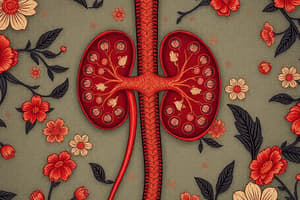Podcast
Questions and Answers
What is the glomerular filtration rate (GFR) in a healthy individual?
What is the glomerular filtration rate (GFR) in a healthy individual?
- 150 ml/minute
- 125 ml/minute (correct)
- 100 ml/minute
- 180 ml/minute
Which part of the nephron is primarily responsible for the reabsorption of nearly all essential nutrients?
Which part of the nephron is primarily responsible for the reabsorption of nearly all essential nutrients?
- Distal Convoluted Tubule (DCT)
- Henle's Loop
- Proximal Convoluted Tubule (PCT) (correct)
- Collecting Duct
What mechanism does the juxta glomerular apparatus (JGA) use to regulate GFR when it falls?
What mechanism does the juxta glomerular apparatus (JGA) use to regulate GFR when it falls?
- Increase in urine output
- Closure of afferent arterioles
- Secretion of renin (correct)
- Release of aldosterone
Which segment of the nephron is impermeable to water but allows for the transport of electrolytes?
Which segment of the nephron is impermeable to water but allows for the transport of electrolytes?
What percentage of the filtrate formed is typically reabsorbed by the renal tubules?
What percentage of the filtrate formed is typically reabsorbed by the renal tubules?
Which ions are selectively secreted by the Distal Convoluted Tubule (DCT) to maintain pH balance?
Which ions are selectively secreted by the Distal Convoluted Tubule (DCT) to maintain pH balance?
Which process explains how substances like glucose and amino acids are reabsorbed in the nephron?
Which process explains how substances like glucose and amino acids are reabsorbed in the nephron?
What occurs in the descending limb of Henle's loop?
What occurs in the descending limb of Henle's loop?
Flashcards are hidden until you start studying
Study Notes
Glomerular Filtration Rate (GFR)
- The glomerular filtration rate (GFR) measures the amount of filtrate formed by the kidneys per minute.
- A healthy individual's GFR is approximately 125 ml/minute, which equates to 180 liters per day.
- The juxta glomerular apparatus (JGA) helps regulate GFR.
- The JGA is located where the distal convoluted tubule and afferent arteriole meet.
- A decrease in GFR can activate the JGA to release renin, which increases glomerular blood flow, bringing the GFR back to normal.
- 99% of the filtrate is reabsorbed by the renal tubules, leaving only 1.5 liters of urine per day.
- Tubular epithelial cells in different segments of the nephron actively or passively reabsorb filtrate.
- Glucose, amino acids, and Na+ are actively reabsorbed, while nitrogenous wastes are passively reabsorbed.
- Water is passively reabsorbed in the initial segments of the nephron.
Function of the Tubules
Proximal Convoluted Tubule (PCT)
- PCT is lined with simple cuboidal brush border epithelium, increasing the surface area for reabsorption.
- The PCT reabsorbs nearly all essential nutrients, 70-80% of electrolytes, and water.
- The PCT helps maintain pH and ionic balance by selectively secreting hydrogen ions, ammonia, and potassium ions into the filtrate and absorbing HCO3 from it.
Henle’s Loop
- The ascending limb of Henle's loop has minimal reabsorption.
- The descending limb of Henle’s loop is permeable to water but impermeable to electrolytes, concentrating the filtrate.
- The ascending limb is impermeable to water but allows transport of electrolytes, diluting the concentrated filtrate as it moves upward.
Distal Convoluted Tubule (DCT)
- The DCT conditionally reabsorbs Na+ and water.
- The DCT reabsorbs HCO3 and selectively secretes hydrogen and potassium ions and NH3 to maintain pH and sodium-potassium balance in the blood.
Collecting Duct
- Water reabsorption occurs in the collecting duct, regulated by antidiuretic hormone (ADH).
- ADH increases the permeability of the collecting duct to water, leading to increased water reabsorption.
- The collecting duct also reabsorbs Na+ and secretes K+ and H+ ions.
- The collecting duct's final filtrate becomes urine.
Studying That Suits You
Use AI to generate personalized quizzes and flashcards to suit your learning preferences.




